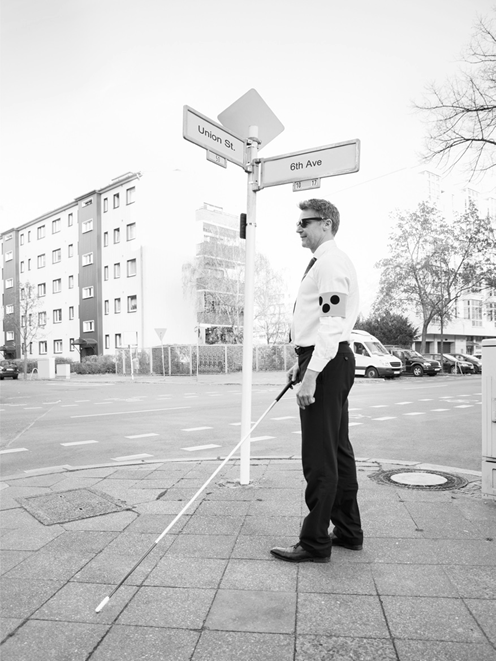
When the first white men arrived on the island of Samoa, they discovered blind men who could see well enough to describe things in detail just by holding their hands over objects. In France, just after the First World War, Jules Romain tested hundreds of blind people and found a few that could tell the difference between light and dark. He discovered through countless tests that they were “seeing” through areas on the nose or on the fingertips. In Italy, the scientist Cesare Lombroso discovered a blind girl who could “see” with the tip of her nose and the lower part of her left ear. When a bright light was shone unexpectedly on her ear she pulled her head away as if in pain. In 1956, a blind schoolboy in Scotland was taught to tell the difference between different coloured lights and learnt to pick out bright objects several feet away.
In 1960, a medical board examined a girl in Virginia and found that, even with bandages and tape over her eyes, she was able to distinguish different colours and read short sections of large print. These few examples, taken from the thousands of possible examples, clearly show that the phenomenon of “eyeless sight” is obviously not new. However, it has reached new peaks of sensitivity in an amazing woman from a mountain village in Russia.
Unbelievable as it may seem, Rosa Kuleshova really does seem to be able to see with the tips of her fingers. We often read of cases where a disability in one sense can lead to another of the senses becoming extremely well-developed to compensate. However, Rosa is not blind, but from growing up in a family of blind people she learnt to read Braille and from this she learnt to do other unbelievable things with her hands. In 1962, her physician took her to Moscow, where she was examined by the Soviet Academy of Science and suddenly became famous throughout Russia, if not a large part of the world. A scientist called Shaefer made an intensive study of her and found that, even when she was securely blindfolded with only her arms stuck through a screen, she could still tell the difference between three different colours simply by touching them.
To test the possibility that the coloured cards reflected heat differently, he heated some of them and cooled others. This did not affect her response at all. He also found that she could read from newspaper articles that had been placed under a sheet of glass, so her sense of touch could not be giving her any information. When she was tested by a psychologist, she was able to identify the colour and shape of patches of light which were shone onto her hand or onto a screen. In carefully controlled tests, with a blindfold and a screen and a piece of card around her neck so wide that she could not see round it, Rosa read the small print in a newspaper with her elbow. And, in the most convincing test of all, she repeated these things with someone standing behind her pressing hard on her eyes. It would be very difficult to cheat in this situation. It is even difficult to see clearly for minutes after the pressure on the eyes is taken away.
Rosa really started something in Russia. Following her success, other tests were made and it was found that about one in every six people could learn to tell the difference between two colours after only an hour’s training. There was soon a class of about eighty students training in what was being called “eyeless sight.” They agreed that different colours “feel” slightly different. Some are more or less smooth to the touch. Yellow is very slippery, red is sticky, and so on. Even when the colours were placed under glass, the students could still somehow “feel” these differences in the air above the colours. These students all had perfectly good sight without their blindfolds and so accusations of cheating were always possible.
However, at another institute the same skills were being taught to the blind. Many sightless people said during these lessons that they had always been aware of the differences in “feel” between the colours, but nobody had ever told them what these meant. Some of the more advanced students in the classes for the blind are now even reading colours through a sheet of metal. They are “seeing” things that even their teachers cannot see.

The fact that blind children are “seeing” with their ears and tongues and tips of their toes suggests that there are no special sensory cells at work, but the ability to see is scattered throughout the body and is common to all cells. It is clear that different types and strengths of light affect the cells in different ways and that one can learn to appreciate this difference and recognize the differing types of light. This explains why the Russians have found that this ability is best in bright light and becomes less accurate, just as normal sight does, as darkness falls. But it does not explain why some people can see through sheets of metal or why the ability fails if the object (or the hand of the person) is electrically earthed.
This is where what is sometimes called “the sixth sense” comes in. It seems that we do, in fact, all have an additional sense that has never been developed. The idea of a sixth sense is usually ridiculed as something only seen in films. However, if the idea is approached from a scientific angle, then the possibilities are both real and immensely exciting.
The ability of “eyeless sight” is strongest in children and reaches a peak at the age of 11. It seems that the human body has a similar system to that of the bat or the whale: a kind of sonar system that can receive and send information in meaningful patterns. When one of our normal senses fails, this extra sense takes over and helps the remaining senses. However, it could be in everybody’s sense system, even people with perfect sight. It is “feeling” the area around us like the whiskers of a cat, giving us information that could be important for our survival. Unfortunately, after the age of about 11 our mind controls our senses more fully and rejects the extra information because it doesn’t believe it is possible. In other words, our reason or sense of logic rejects what could be a wonderful ability simply because it doesn’t understand it, just as it does with so many other things it doesn’t understand. Hopefully, one day, when more and more people like Rosa Kuleshova are found, our reason will be able to accept this ability as normal, even if it cannot explain or understand it.
Surely our lives will be greatly improved on that day, but imagine what it would mean to the millions of blind people around the world. All we need is a greater faith in our own abilities and a willingness to trust our instinct a little more and our reason a little less.



